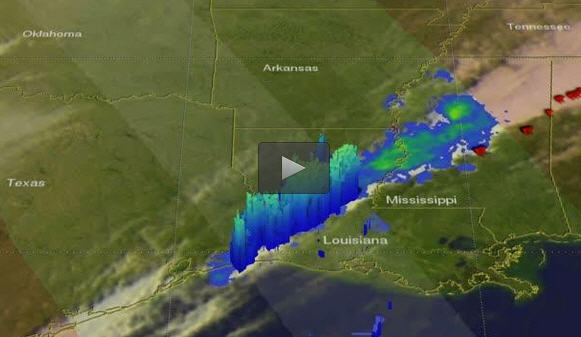

The GPM core observatory satellite viewed a western portion of a line of violent weather when it flew over on Tuesday, Nov. 29 at 11:16 p.m. EST. The areas covered by GPM's Microwave Imager (GMI) and Dual-Frequency Precipitation Radar (DPR) instruments are shown in lighter shades. Red symbols show the approximate locations where tornadoes were reported.
Credits: NASA/JAXA, Hal Pierce
Tornadoes caused the deaths of at least five people in northern Alabama. Storms also took the lives of two people in Tennessee.
This rainfall may provide some relief to drought ridden eastern Tennessee where destructive wildfires have been occurring. Some storms were accompanied with hail, strong winds and intense showers. Golf ball sized hail was reported in a storm that passed through Louisiana Tuesday evening.
The GPM core observatory satellite viewed a western portion of a line of violent weather when it flew over on Tuesday, Nov. 29 at 11:16 p.m. EST (November 30, 2016 0416 UTC). GPM found that rain was falling at a rate of over 5.7 inches (144.8 mm) per hour in a heavy downpours over southwestern Louisiana.
At NASA's Goddard Space Flight Center in Greenbelt, Maryland, GPM's Dual-Frequency Precipitation Radar (DPR) data was used to produce a 3-D view of the precipitation within storms that were moving over Louisiana. Storm tops were measured by GPM's radar (Ka and Ku band) reaching heights above 8 miles (13 km).
On Nov. 30, NOAA's National Weather Service Storm Prediction Center (SPC) noted “Storms will be capable of producing damaging winds, hail, heavy downpours, and a few tornadoes.
Heavy rainfall could lead to localized flooding of low lying and poor drainage areas. Additional heavy rainfall will also be possible from the Appalachians to the Middle Atlantic Region.” For updated information from the SPC, visit: http://www.











